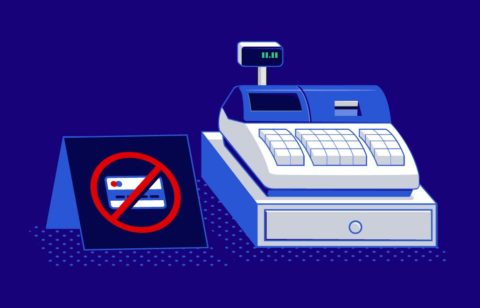Americans, today, have never been in so much debt. The level of consumer debt in America has risen dramatically over the last decade, particularly in the last couple of years. With the economy struggling for so long, and the Federal Reserve holding fast to low interest rates these past years, this trend is likely to continue. In fact, by the end of the first quarter of 2017, the household debt of American families surpassed the previous high of 2008 when the U.S. economy nearly collapsed and the Great Recession began.
The cost of living has outpaced income growth in America for the last 10 years, and this has contributed greatly to the rise in credit card debt. Because families do not have enough income to make ends meet, credit cards have become a way to bridge the cash shortfalls. In addition, banks have significantly eased their lending standards as more and more consumers have been able to repair their credit in the last few years. This has made it easier and easier for consumers to obtain credit cards and accumulate more debt.
American families have been particularly hard hit. Even with both parents working, raising a family is expensive. With rising overhead costs such as rent, utilities, groceries, and gas, the ability to keep up financially has never been harder. Add in the large expense of childcare for working families and things get exponentially more difficult with the arrival of each child. Moreover, as children grow, basic expenses aren’t alone in breaking the budget; the costs of doctor visits, school supplies, and extracurricular activities enter the fray.
When income does not reach the end of the month, many turn to credit cards to make ends meet. Without some kind of change, in the form of increased income or reduced expenses, this situation could lead to insolvency. However, if families work together and are diligent in their efforts, they can stop accumulating debt and, ultimately, pay it off. Here are a few ideas and strategies to consider.
Formulate a working budget
Many Americans, in fact most, have never created a budget, much less utilized one to manage their money. Most families know where the money goes when it comes to the big-ticket items such as rent or mortgage, but really have no idea where the rest of their money goes. Formulating a budget helps consumers understand how they are spending their money and where they can tighten their belts to help make ends meet.
Luckily, there are many resources online for families to turn to for advice and instruction on building and following a monthly budget. Sometimes, just raising the awareness of consumers about how they are spending their money can help reign things in. Sitting down and making a list of all expenses means sifting through a couple of months of bank and credit card statements. Once you have a clear understanding of where your money is going, you will be able to identify ways to cut back. Without a budget, you are essentially flying blind each month and, more than likely, you will exceed your income and have to rely on credit cards to get by.
Eliminate wasteful spending
Formulating your budget will help you identify areas of spending that are wasteful and unnecessary. You will most likely find a good amount of frivolous spending that will be easy to eliminate to create extra cash flow. These could include things such as subscriptions and other recurring charges that you may have even forgotten about. Daily expenditures such as gourmet coffee and expensive lunches out can easily be replaced with less expensive alternatives. Also, review your standard accounts such as cable, phone, and electricity to find ways to eliminate or reduce your charges. Often, you can reduce these bills substantially through awareness and eliminating services you no longer need or desire.
The most important distinction you should make when it comes to your expenditures is whether they are necessary or unnecessary. If they are necessary, such as your utility bill, look for ways to reduce them such as turning off lights and adjusting your thermostat. If the expense is unnecessary, eliminate it or reduce its frequency. For instance, dining out could become a special occasion rather than an everyday occasion.
Increase your income
Increasing your income by adding a second job or starting a small business on the side is a very good way to get your finances on track and help pay off debt. By adding the extra income, you accomplish two things. First, you stop the budget shortfalls that create the credit card debt. Second, you create a larger capacity for paying off your debt. If you are just paying minimums on your credit cards, you will end up paying an enormous amount of interest over time. In addition, it could take an extraordinary amount of time to pay off your debt.
Bringing in that extra cash will only help you, though, if you have a solid plan on how to utilize the money. Make sure that you are not increasing your spending because you now have extra income. Otherwise, you will do nothing to improve your finances and will be back to spinning your wheels.
Save for an emergency fund
When you are formulating your budget, be sure to allocate some of your monthly income to an emergency fund. Some of the biggest budget busters are unexpected big-ticket items such as household appliances, car repairs, or a big medical bill. If you do not have an emergency fund to fall back on, you will likely have to rely on credit cards to fund the expense. Using credit cards to tackle large, unexpected budget shortfalls is a fast way to get into a lot of debt.
Most financial experts agree that families should save a minimum of $1,000 in their emergency fund. However, more is better since many big-ticket, unexpected expenses cost much more than that. Keep saving even if you have reached the $1,000 mark.
In addition, if you can think of ways to jumpstart your emergency fund, utilize them. Selling items that you no longer need via online auction sites such as eBay or by having a garage sale is a great way to raise cash.
Close your credit card accounts
The only way to stem the rise of your credit card balances is to stop using them. If you have stored up your expenses and saved your emergency fund, you may want to consider closing your credit card accounts. While this may temporarily lower your credit score, it will keep you from accumulating more debt. Moreover, if you are seriously trying to get your debt under control, you shouldn’t be applying for any new credit. In addition, if you are struggling to pay your credit cards, chances are high that you’ve already negatively affected your credit anyway.
Some consumers feel more comfortable keeping one credit card account open in case they have an unexpected expense that the emergency fund won’t cover. If this is what you choose to do, put it away and try to forget you have it. Don’t carry it in your wallet, as doing so may tempt you to make purchases you really cannot afford.
Increase your credit card payments
Many consumers pay only the minimum amount due on their credit cards each month. If this is what you are doing, you need to increase the amount you pay. Paying only the minimum due each month will cause you to pay on your credit card for a very long time, as minimum payments mostly consist of interest with a small portion going toward the principal balance. By paying on them for such a long time, you will pay an astronomical amount of interest. If you want to know the details on this, just look at your monthly statement. All statements must show how long it will take to pay off the debt if you just pay the minimum. Frankly, it will shock you.
Spend your food and entertainment dollars wisely
Meals and entertainment represent a substantial amount of dollars in a family’s budget. This area of a family’s finances often bleeds the most cash. By carefully watching the expenditures in this category and managing these dollars effectively, a family can save a significant amount of money.
Meals made at home are much more economical than meals eaten out in a restaurant. Meal planning assures that you have everything need to make these meals and will eliminate the temptation to go out or order in. It will also keep you from overspending at the grocery store by eliminating impulse buys and unnecessary purchases.
Packed lunches are a great way to save money. Think of it this way: If both working parents eat lunch out every day and they spend $12 dollars per day each, a modest amount, they will spend almost $500 a month!
Dining out with a family can be expensive, so look for restaurants that have family-friendly menus and specials designed to attract families on a budget. When it comes to entertainment, get creative. Instead of seeing a movie in the theater, for example, look for local family events, such as a movie in the park where you can pack a picnic. Managing your food and entertainment expenses creatively can be a fun and productive way to spend more quality time together as a family, and save a lot of money in the process. Additionally, you can direct the money you save to your credit card balances to help you pay them off quicker and with less interest.
Don’t buy new
Resist the temptation to buy everything new. By shopping in secondhand stores and consignment shops, you can save a significant amount of money on items you need. Often, these items are in excellent shape and you can acquire them for mere pennies on the dollar.
Things such as furniture, appliances, and clothing are often some of the best bargains out there, especially children’s items such as nursery furniture, clothing, and toys, which can be very expensive when purchased new. Additionally, shopping secondhand can be fun and rewarding.
You can also sell items you are no longer using to secondhand stores and consignment shops if they are in good condition. This can generate some extra cash and de-clutter your home, which will make things less stressful. In addition, many online outlets let you sell items you no longer need. Any cash you make should go directly to your unpaid debt.
Make a plan
The most important thing to remember is that it will most likely take a multi-pronged approach to solve your debt problem. If you have fallen behind, do everything you can to raise the cash to get current and stay current. From that point forward, you can utilize some of the strategies outlined here to work on your debt and get it paid down. Having a solid plan will increase your chances of succeeding.
If you wait too long, you often limit your options, so get started as soon as possible. If you have fallen too far behind, there are other options besides bankruptcy. Bankruptcy is a catastrophic financial event for your family, so do everything in your power to avoid it. Working with a debt settlement company such as National Debt Relief can help you work with your creditors to reach a full and final resolution to your debt problem.
Whatever your situation, get started today on getting control of your finances and put yourself on the path to a debt-free life.





